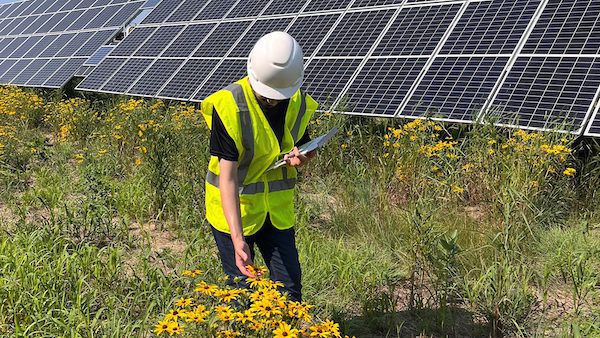Fwd: Solar farms and native grasses create pollinator havens and boost biodiversity, study funds | RenewEconomy
Putting solar farms on agricultural land can not only create hubs for insect biodiversity but also help to mitigate the rising conflict of land use change, new research says. The five-year, US-based study found planting native grasses and flowers under solar panels helps insect populations to massively improve – by up to 20 times in the case of native bee populations. Researchers from the US Department of Energy’s Argonne National Laboratory and the National Renewable Energy Laboratory planted native grasses and flowers at Enel Green Power North America’s Atwater and Eastwood solar farms, in southern Minnesota. From 2018 to 2022, researchers conducted 358 observational surveys at the two sites to map flowering vegetation and insect communities. “The effort to obtain these data was considerable, returning to each site four times per summer to record pollinator counts,” said Heidi Hartmann, manager of the land resources and energy policy program in Argonne’s Environmental Sciences division, and one of the co-authors of the study, published in Environmental Research. “Over time we saw the numbers and types of flowering plants increase as the habitat matured. Measuring the corresponding positive impact for pollinators was very gratifying.” The results show that insect abundance tripled and diversity rose by 150 per cent. The team saw increases in the abundance and diversity of native insect pollinators and agriculturally beneficial insects such as honeybees, native bees, wasps, hornets, hoverflies, other flies, moths, butterflies and beetles. These insects were also seen on neighbouring soy beans farms. “This research highlights the relatively rapid insect community responses to habitat restoration at solar energy sites,” said Argonne landscape ecologist and environmental scientist Lee Walston. “It demonstrates that, if properly sited, habitat-friendly solar energy can be a feasible way to safeguard insect populations and can improve the pollination services in adjacent agricultural fields.” Even bees have got to eat Global insect biodiversity has been in decline due to habitat loss, pesticides and climate change but pairing restoration efforts with renewable energy developments could help reverse the course. Sites with the biggest solar-pollinator habitat potential are likely to be those that have been ecologically compromised, such as marginal farmland, former industrial or mine lands, and other disturbed sites. But even on lush farmland, the research suggests that well-sited solar farms can play a big role in protecting and conserving biodiversity and pollinator habitats and mitigate land-use conflicts associated with the conversion of farmland for solar energy production. In Australia, that conflict is well entrenched with complaints against new solar farms often including the fear that more prime agricultural land is being removed in the name of energy production. But the swift and sudden embrace of agrisolar, where animals share paddocks with solar panels, is creating a new way for farmers keen on solar to fend off complaints from that direction. By adding pollinator habitats to the concept of agrivoltaics – an essential service in a country where bees are trucked around rural areas to pollinate major crops from mango through to avocado, blueberry, macadamia and almond – improves a site’s land use efficiency and ecosystem services output, the US study says. “The United States has lost over 12 million acres of agricultural land since 2015, increasing the pressure on the remaining agricultural lands for food production,” the study notes. “Solar energy development may contribute to further declines in farmland, as approximately 80 per cent of future ground-mounted solar energy development could occur on agricultural lands. “Rather than exacerbate the effects of these land use tradeoffs, these effects can be alleviated through the proper siting of solar energy developments and pairing with solar-pollinator habitat or other agrivoltaic dual land uses.”
Image: Argonne National Laboratory/Lee Walston. An Argonne scientist surveys for pollinators at a utility-scale solar facility.
- Log in to post comments


